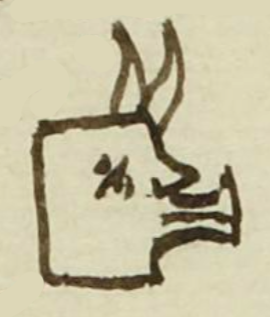Quetzalecatl (MH777v)
This is a black-line drawing of the compound glyph for the personal name Quetzalecatl (literally, Quetzalli feathers-Air, but it is the name of a divine force). This illustrious name is attested here as pertaining to a tribute-paying man. The glyph shows two quetzal feathers attached to the top of a square but anthropomorphic head, shown in profile and facing toward the viewer's right. The face has a buccal mask, something like a duck bill, which is associated with the divine force of the wind, Ehecatl.
Stephanie Wood
There is a pictorial map in the Library of Congress that bears the name Codex Quetzalecatzin (which is the reverential version of the same name shown here), but a different person than the one shown here. That mapa is also known by two place names, Ecatepec ahd Huitziltepec, of southeastern Puebla and northern Oaxaca.
There was a Quetzalecatzin (or Quetzalecatl, without the reverential suffix) was a tlahtoani of Tecamachalco (now in the state Puebla) in the fifteenth century. Apparently, his name points to a tradition that links Quetzalcoatl with Ehecatl in the figure of Nahui Ehecatl, as shown in the Codex Telleriano Rememsis. Quiñones Keber "goes on to say that ... it was related to the Tepictoton, or dough image mountain representing the tlatoque or rain gods," according to Viviana Díaz Balsera (Guardians of Idolatry, 2018, 123). The latter adds: "Recall that in the Legend of the Suns, four colored tlatoque snatched the maize bounty that was revealed after lightning (Nanahuatl) opened up the Food Mountain, discovered by Quetzalcoatl (Bierhorst 1992, 146–47; Feliciano Velázquez 1992, 121). Hence, the dual image of Nahui Ehecatl Quetzalcoatl as patron may allude to this tradition."
Gabrielle Vail and Christine Hernández (Re-Creating Primordial Time, 2013) describe Ehecatl as the wind aspect of Quetzalcoatl, and they note that Ehecatl "wears a buccal (duck) mask through which to blow wind." That the "beak" may have been perceived as a blowing device is supported by the glyph for Pitztli (below).
Stephanie Wood
dieo queçalecatl
Diego Quetzalecatl
Stephanie Wood
1560
Jeff Haskett-Wood
winds, viento, deidades, divinidades, fuerzas divinas, nombres de hombres, feathers, plumas

quetzal(li), quetzal feathers, https://nahuatl.wired-humanities.org/content/quetzalli
eca(tl), air, breath, https://nahuatl.wired-humanities.org/content/ecatl
eheca(tl), wind or divine force of the wind, https://nahuatl.wired-humanities.org/content/ehecatl
Quetzal-Aire, o Quetzal-Viento
Stephanie Wood
Matrícula de Huexotzinco, folio 777v, World Digital Library, https://www.loc.gov/resource/gdcwdl.wdl_15282/?sp=629&st=image
This manuscript is hosted by the Library of Congress and the World Digital Library; used here with the Creative Commons, “Attribution-NonCommercial-ShareAlike 3.0 License” (CC-BY-NC-SAq 3.0).






